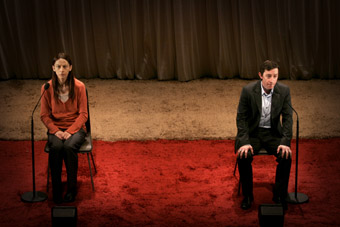a quiet kind of terror
bryoni trezise is witness to aalst

Kate Dickey, David McKay, Aalst, National Theatre of Scotland
photo Prudence Upton
Kate Dickey, David McKay, Aalst, National Theatre of Scotland
AALST PRESENTS A SIMILAR PICTURE OF SOCIAL DESTITUTION TO URBAN THEATRE PROJECT’S THE LAST HIGHWAY [P12] BUT IN THE VERY DIFFERENT CLOSE-UP MODE OF INTERROGATION. CATHY AND MICHAEL DELANEY (KATE DICKEY AND DAVID MCKAY) ARE NOT MERELY THE SOCIALLY EXCLUDED, THEY ARE SPECIMENS OF THE SOCIALLY DESPISED: DOLE-BLUDGERS AND NO HOPERS AND—SENSATIONALLY—MURDERERS OF THEIR OWN CHILDREN. OUR ROLE IN HEARING THEIR TESTIMONY IS AMBIGUOUS. WE ARE FIRST POSITIONED AS THEIR JURY AND THEN LATER, AS THEIR CO-CONSPIRATORS AS WE UNCOMFORTABLY REALISE THAT THE TRIAL WE HAVE BEEN STEADILY WATCHING HAS BEEN A DUMMY RUN, A PREP-GO TO GET THE TEARS FLOWING FOR AN EVENTUAL DAY IN COURT.
The Delaneys are fictional representations of an actual Belgian couple who murdered their two children while living in the industrial town of Aalst. Scottish playwright Duncan Mclean translated the original Belgian play (which was based on film access to the couple’s trial) into English with the help of director Pol Heyvaert. The result is a theatricalised verbatim-style piece that plays with our trust of both the speakers and the form. This makes for a compelling audience journey: as watchers our moral incredulity is often overtaken by a more aesthetic necessity to suspend disbelief, to trust that what we are receiving is from a dependable confessional source.
Aalst is less interested in moral sensationalism than in a more earnest exploration of the psyches of two child-killers. We hence traverse the complex social circumstances that might produce the rare event of infanticide. Being reared in orphanages and foster care, and enduring sexual abuse and violence within their own relationship are just some of the histories driving the actions the couple take. Less explicable—although pointed—is the candid and perfunctory dismissal of ‘normal’ living structures the couple demonstrates: “Why weren’t the debts paid?” they are asked. “Possibly we didn’t feel like it”, comes the steady reply.
Performers Kate Dickey and David McKay are exceptional in striking the subtle chord that keeps the audience hovering between empathy and disgust. Dickey’s whole physique and the the quizzical tone of her reasoning embody the mindspace of a character who is possibly beyond comprehension. “What we did was horrific”, Cathy explains knowingly. Her logic makes excruciating sense—somehow. Are we convinced? We don’t know what to think.
Aalst’s provocation rests less in the horrific details of what is played out and more in the way we respond as an audience, eager to condemn the wicked. When this ambiguity is articulated, the piece is strong, and when it wavers, a less dynamic sense of omnipotent judgement frames the pair.
Both Aalst and The Last Highway push the question of whose stories we tell through theatre and why and how we watch those stories play out. Each work, too, drifts into and out of a quiet kind of terror—an almost seething terror, not of horrendous crimes, but of the very bathos of existence, the torpor that sometimes drives people to the edge of something that is mostly kept comfortably at bay.
National Theatre of Scotland, Aalst, writer Duncan Maclean from original texts by Pol Heyvaert and Dimitri Verhulst, director/designer Pol Heyvaert, performers Kate Dickey, David McKay, Gary Lewis, lighting Paul Claydon, sound Matthew Padden; Carriageworks, Sydney, Jan 18-23
RealTime issue #83 Feb-March 2008 pg. 13






